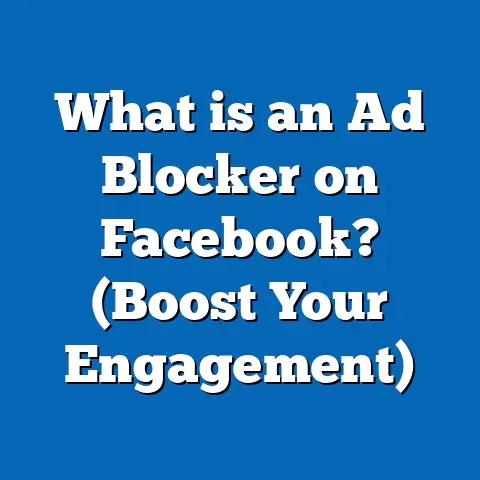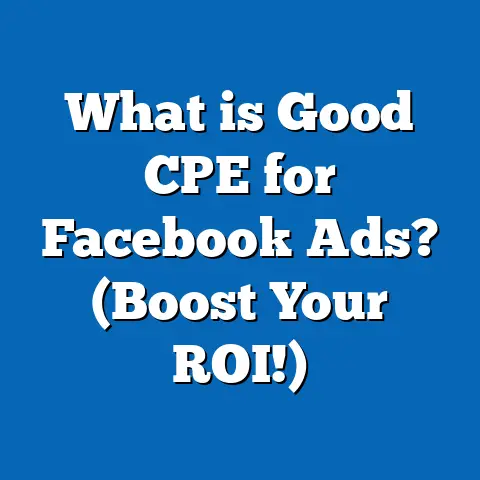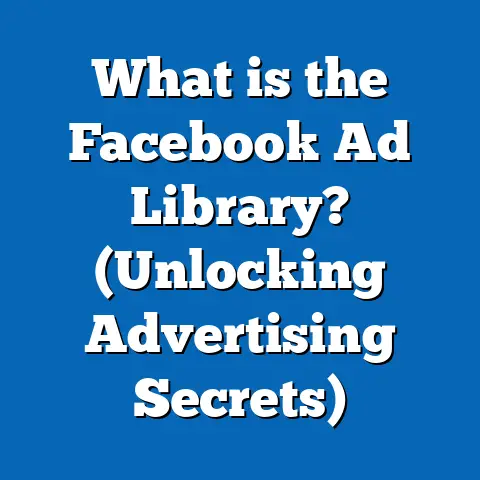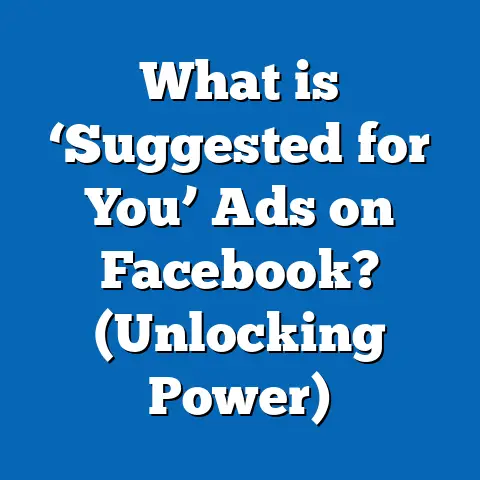What is a Feature Phone Facebook Ad? (Unlocking Mobile Reach)
What is a Feature Phone Facebook Ad? (Unlocking Mobile Reach)
Introduction: Debunking Durability Myths and Unveiling Mobile Reach Potential
Feature phones have long been considered relics of a bygone era dominated by smartphones. The common perception is that these devices are outdated, only useful for calls and texts, and essentially irrelevant for modern digital marketing strategies. They are often praised for their durability and long battery life, which sometimes leads to the misconception that they are simply fallback devices for users who can’t afford or don’t want smartphones.
However, this narrative overlooks a critical fact: feature phones remain the primary gateway to the internet for a substantial portion of the world’s population. According to GSMA Intelligence (2023), over 1.1 billion people use feature phones as their main mobile device. These devices are particularly prevalent in developing economies, where smartphone adoption is still growing but not yet dominant.
For marketers, this means ignoring feature phone users equates to missing out on a massive and often underserved audience segment. Facebook has recognized this opportunity and developed advertising solutions tailored specifically for feature phones, enabling businesses to reach users at scale with tailored content that fits their device constraints.
Understanding Feature Phone Facebook Ads
What is a Feature Phone?
Feature phones are basic mobile devices designed primarily for voice calls, SMS texting, and limited internet access. Unlike smartphones, they lack advanced operating systems like iOS or Android and generally do not support downloadable apps beyond pre-installed software.
Key characteristics include:
- Physical Keypads: Most feature phones use numeric keypads rather than touchscreens.
- Small Screen Size: Typically 2–3 inches diagonal.
- Network Limitations: Primarily operate on 2G or 3G networks.
- Limited Multimedia: Support basic audio and low-resolution images.
- Affordable Pricing: Usually priced below $50, making them accessible in low-income markets.
Despite these limitations, feature phones remain popular because they offer reliable communication with long battery life and durable build quality.
The Global Feature Phone Market
The feature phone market is concentrated in emerging regions where smartphone penetration is still evolving. Some notable statistics:
- India: Approximately 60% of mobile users still use feature phones (Statista, 2024).
- Africa: Over half of all mobile subscribers use feature phones (GSMA Intelligence 2023).
- Southeast Asia: Countries like Indonesia and the Philippines show significant feature phone usage in rural areas.
- Latin America: Feature phone penetration remains relevant in remote or low-income regions.
This global footprint means feature phone users represent a massive potential audience for digital marketing campaigns when advertisers tailor their approach accordingly.
What Are Feature Phone Facebook Ads?
Facebook created specific ad formats optimized for feature phones to address their unique constraints. These ads appear in environments frequently accessed by feature phone users:
- Facebook Lite: A lightweight version of Facebook designed for low-end devices and slow networks.
- Messenger Lite: A simplified messaging app optimized for feature phones.
- Partner Platforms: Certain third-party apps and platforms integrated with Facebook’s ad network accessible via feature phones.
Feature phone Facebook ads differ technically from standard smartphone ads:
- Reduced file sizes to accommodate slow internet speeds.
- Simplified interactive elements due to limited touch functionality.
- Emphasis on clear text and visuals that display well on small screens.
Why Feature Phone Facebook Ads Matter
Unlocking Massive Untapped Mobile Audiences
Ignoring feature phone users excludes a significant share of the global mobile audience. This segment often includes:
- Rural populations with limited infrastructure.
- Low-income consumers prioritizing affordability over advanced features.
- Older demographics less inclined toward smartphones.
Facebook’s platform insights indicate that feature phone users actively engage with social media content daily via Facebook Lite and Messenger Lite. This engagement translates into valuable advertising opportunities.
Cost Efficiency in Advertising
Advertising on feature phones generally costs less than targeting smartphones due to:
- Lower competition for ad placements on these platforms.
- Reduced data consumption resulting in cheaper campaign delivery.
- High engagement rates that improve ad relevance scores and reduce cost per result.
Enhanced User Engagement Characteristics
Feature phone users often exhibit different engagement patterns:
- Longer session times on lightweight apps due to limited alternatives.
- Higher responsiveness to straightforward calls to action (CTAs).
- Preference for content in local languages and simple formats.
Marketers who understand these traits can design better campaigns that resonate with this audience.
Technical Aspects of Feature Phone Facebook Ads
Available Ad Formats Explained
Facebook provides several ad formats optimized for feature phones:
- Text Ads:
- Primarily composed of concise headlines and descriptive text.
- Minimal or no image use to ensure quick loading.
- Suitable for awareness campaigns focusing on brand messaging.
- Image Ads:
- Single image ads with compressed graphics.
- Use of bright colors and bold fonts enhances visibility on small screens.
- Ideal for promotions, product highlights, or event announcements.
- Carousel Ads (Limited):
- Carousel ads exist but are simplified with fewer cards.
- Limited interactivity due to device constraints.
- Useful for showcasing multiple products or features in a compact format.
- Messenger Ads:
- Delivered within Messenger Lite or basic messaging apps.
- Often text-based with optional image attachments.
- Facilitate direct interaction via replies or clicks on CTAs like “Send Message.”
Network Optimization Techniques
Feature phones typically connect via slower 2G or 3G networks with limited bandwidth. Facebook employs several technical strategies to optimize ad delivery:
- Adaptive Compression: Images and videos are compressed dynamically based on network speed.
- Progressive Loading: Ads load essential content first to display quickly.
- Minimal Tracking Scripts: Reducing scripts to decrease load times without sacrificing tracking accuracy.
These optimizations ensure that even users on marginal networks receive ads promptly and fully rendered.
Targeting Capabilities Specific to Feature Phones
Facebook’s ad manager allows advertisers to segment audiences based on device type. Key targeting options include:
Africa
In Sub-Saharan Africa, infrastructure limitations restrict smartphone proliferation. Feature phones remain dominant for internet access in rural areas. Facebook’s partnership with telecom operators here focuses heavily on feature phone ad placements.
Southeast Asia & Latin America
Similar trends appear in rural Indonesia, Philippines, and parts of Latin America where affordability drives feature phone preference. Localized content and language support enhance ad performance in these markets.
Case Studies: Successes with Feature Phone Facebook Ads
Case Study 1: FMCG Brand in Rural India
Background
A fast-moving consumer goods (FMCG) brand sought to increase awareness of a new product line targeting rural consumers who primarily use feature phones.
Strategy
- Leveraged Facebook Lite targeted ads optimized for low bandwidth.
- Used simple image ads with bold visuals and minimal text in local languages.
- Applied geographic targeting focused on districts with high feature phone usage.
Results
- Brand recall increased by 25% within three months.
- Cost per impression decreased by 30% compared to smartphone-only campaigns.
- Engagement rates (click-throughs) surpassed industry averages by 15%.
Case Study 2: Microfinance Institution in East Africa
Background
A microfinance company wanted to promote mobile loan services among rural populations using Messenger Lite.
Strategy
- Created conversational Messenger ads with simple call-to-action buttons like “Apply Now.”
- Used short text messages combined with lightweight images.
- Targeted users based on device type (feature phone) and network connectivity (2G/3G).
Results
- Loan inquiries rose by 40%.
- Conversion rates improved by 15%.
- Campaign ROI was double the previous smartphone-centric efforts.
How to Create Effective Feature Phone Facebook Ads
Step 1: Conduct Comprehensive Audience Research
Understand your audience’s:
- Device usage patterns
- Network conditions
- Language preferences
- Behavioral tendencies
Use Facebook Audience Insights to filter by device type and region. Supplement this with third-party research or surveys if necessary.
Step 2: Select Suitable Ad Format
Due to device constraints:
- Prefer text ads or single image ads.
- Avoid heavy video content unless properly compressed.
- Use carousel ads sparingly due to limited interaction features.
Step 3: Optimize Visuals & Copy for Small Screens
Tips include:
- Use high contrast colors for visibility.
- Large fonts that remain legible at small sizes.
- Clear, concise messaging focused on one idea per ad.
- Avoid cluttered images or excessive detail.
Step 4: Set Precise Targeting Parameters
Focus targeting on:
- Device types (feature phones)
- Network connections (2G/3G)
- Geographic locations with high feature phone adoption
- Languages spoken locally
Such precision improves relevance and reduces wasted spend.
Step 5: Choose the Right Bidding Strategy
For many campaigns targeting cost-efficiency:
- Use Cost Per Click (CPC) bidding if driving traffic/conversions.
- Cost Per Mille (CPM) bidding may be better for awareness objectives.
Test different bidding options while monitoring performance metrics closely.
Comparing Feature Phone Ads vs. Smartphone Ads on Facebook
| Aspect | Feature Phone Facebook Ads | Smartphone Facebook Ads |
|---|---|---|
| Network Speed | Optimized for slow 2G/3G networks | Designed for fast 4G/5G connectivity |
| Ad Formats | Text, image; limited carousel | Wide variety including video, stories |
| User Interaction | Simple taps; no swipe/pinch gestures | Rich interactive features |
| Screen Size | Small screens (2–3 inches) | Larger screens (5+ inches) |
| Creative Complexity | Minimalist design due to hardware limits | Complex multimedia possible |
| Cost | Generally lower cost per impression | Higher due to competition |
| Reach | High in emerging markets | High globally |
This comparison highlights why advertisers must tailor campaigns based on device capabilities rather than using a one-size-fits-all approach.
Advanced Tips & Best Practices
Use Clear Calls-to-Action (CTAs)
Feature phone users benefit from direct action prompts such as:
- “Call Now”
- “Send Message”
- “Click Here”
Avoid vague CTAs that require complex navigation or multiple steps.
Leverage Local Languages & Cultural Contexts
Ads translated into local dialects significantly boost engagement. Including culturally relevant imagery or references builds trust with audiences unfamiliar with global brands.
Test & Iterate Creatives Frequently
Due to the simplicity required, testing different headlines, images, and CTAs helps identify what resonates best with feature phone users.
Monitor Device-Specific Metrics
Track key performance indicators (KPIs) segmented by device type:
- Click-through rate (CTR)
- Conversion rate
- Bounce rate
Adjust campaigns based on these insights for continuous improvement.
Integrate Offline Campaigns Where Possible
Many feature phone users live in areas where offline marketing remains influential. Combining digital ads with local events or radio promotions can increase brand recall.
Future Outlook: The Evolving Role of Feature Phone Advertising
While smartphone adoption continues rising globally, feature phones will remain relevant for several more years—especially as manufacturers innovate with smart feature phones (e.g., KaiOS-powered devices). These devices bridge basic functionality and smart features at affordable prices.
Facebook is also expanding features available on Lite platforms and improving analytics tools tailored for these devices. Advertisers who adapt early will gain competitive advantages by capturing audiences before smartphone saturation occurs.
Practical Implementation Guide: Launching Your First Feature Phone Facebook Ad Campaign
Step-by-Step Campaign Setup
- Set Objective: Choose from awareness, traffic, engagement, leads, or conversions depending on goals.
- Audience Selection: Use device targeting filters within Facebook Ads Manager to specify feature phones.
- Budget Allocation: Start modestly; monitor performance before scaling.
- Creative Development: Design simple text/image ads using tools like Canva optimized for small screens.
- Launch & Monitor: Use Facebook Analytics and Ads Manager to track key metrics daily.
- Optimize & Scale: Adjust bids, creatives, and targeting based on data insights; increase budget once ROI proves positive.
Tools & Resources
- Facebook Creative Hub for mockups
- Audience Insights for research
- Third-party analytics platforms (e.g., Adjust, AppsFlyer) supporting device segmentation
- Local language translation services for localization
Summary & Key Takeaways
Feature Phone Facebook Ads represent an underutilized but powerful segment of mobile advertising that marketers must not overlook. The ability to reach over a billion users who rely on basic mobile devices opens doors to new markets and revenue streams at competitive costs.
Success hinges on understanding the unique limitations and behaviors of this audience segment—ranging from network constraints to cultural preferences—and tailoring ad creatives accordingly. Data-backed insights confirm higher engagement rates and cost efficiencies when campaigns are thoughtfully executed.
Marketers who incorporate feature phone-focused strategies into their overall mobile advertising mix will unlock significant opportunities, especially in emerging markets where these devices dominate.





